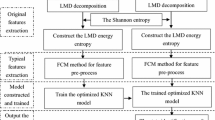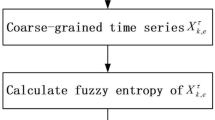Abstract
A fault diagnosis model is proposed based on fuzzy support vector machine (FSVM) combined with fuzzy clustering (FC). Considering the relationship between the sample point and non-self class, FC algorithm is applied to generate fuzzy memberships. In the algorithm, sample weights based on a distribution density function of data point and genetic algorithm (GA) are introduced to enhance the performance of FC. Then a multi-class FSVM with radial basis function kernel is established according to directed acyclic graph algorithm, the penalty factor and kernel parameter of which are optimized by GA. Finally, the model is executed for multi-class fault diagnosis of rolling element bearings. The results show that the presented model achieves high performances both in identifying fault types and fault degrees. The performance comparisons of the presented model with SVM and distance-based FSVM for noisy case demonstrate the capacity of dealing with noise and generalization.
Similar content being viewed by others
References
Vapnik V N. An overview of statistical learning theory[J]. IEEE Transactions on Neural Networks, 1999, 10(5): 988–999.
Vapnik V N. The Nature of Statistical Learning Theory[M]. Springer-Verlag, New York, 1995.
Yuan Shengfa, Chu Fulei. Support vector machines and its applications in machine fault diagnosis[J]. Journal of Vibration and Shock, 2007, 26(11): 29–35, 58 (in Chinese)
Konar P, Chattopadhyay P. Bearing fault detection of induction motor using wavelet and support vector machines (SVMs)[J]. Applied Soft Computing, 2011, 11(6): 4203–4211
Wu Qi. Hybrid fuzzy support vector classifier machine and modified genetic algorithm for automatic car assembly fault diagnosis[J]. Expert Systems with Applications, 2011, 38(3): 1457–1463.
Zhang Junhong, Liu Yu, Ma Wenpeng et al. Typical fault diagnosis of aircraft engine based on GAPSO-SVM[J]. Journal of Tianjin University, 2012, 45(12): 1057–1061 (in Chinese).
Chen Huiling, Liu Dayou, Yang Bo et al. A new hybrid method based on local fisher discriminant analysis and support vector machines for hepatitis disease diagnosis[J]. Expert Systems with Applications, 2011, 38(9): 11796–11803.
Hu Qiao, He Zhengjia, Zhang Zhousuo et al. Fault diagnosis of rotating machinery based on improved wavelet package transform and SVMs ensemble[J]. Mechanical Systems and Signal Processing, 2007, 21(2): 688–705.
Gu Xiaojun. Research on Support Vector Machine Method for Rotating Machine and Intelligent Fault Diagnosis System[D]. Zhejiang University, Hangzhou, 2006 (in Chinese).
Lin C F, Wang S D. Fuzzy support vector machines[J]. IEEE Transactions on Neural Networks, 2002, 13(2): 464–471.
Wang Yongqiao, Wang Shouyang, Lai K K. A new fuzzy support vector machine to evaluate credit risk[J]. IEEE Transactions on Fuzzy Systems, 2005, 13(6): 820–831.
Huang H P, Liu Y H. Fuzzy support vector machines for pattern recognition and data mining[J]. International Journal of Fuzzy Systems, 2002, 4(3): 826–835.
Zhang Xiang, Xiao Xiaoling, Xu Guangyou. Fuzzy support vector machine based on affinity among samples[J]. Journal of Software, 2006, 17(5): 951–958 (in Chinese).
Tang Hao, Liao Yuhe, Sun Feng et al. Fuzzy support vector machine with a new fuzzy membership function[J]. Journal of Xi’an Jiaotong University, 2009, 43(7): 40–43 (in Chinese).
Bezdek J C. Pattern Recognition with Fuzzy Objective Function Algorithms[M]. Plenum Press, New York, 1981.
Liu Xiaofang, Zeng Huanglin, Lu Bingchao. Clustering analysis of partial supervised and weighted fuzzy c-means algorithm[J]. Computer Simulation, 2004, 22(3): 114–116, 129 (in Chinese).
Ding Shifei, Qi Bingjuan, Tan Hongyan. An overview on theory and algorithm of support vector machines[J]. Journal of University of Electronic Science and Technology of China, 2011, 40(1): 2–10 (in Chinese).
UCI Machine Learning Repository. Iris Data Set[EB/OL]. http://archive.ics.uci.edu/ml/data-sets/Iris, 1993-03-08.
Case Western Reserve University Bearing Data Center. Seeded Fault Test Data[EB/OL]. http://www.eecs.cwru.edu/laboratory/bearing/download.htm, 2007-11-27.
Author information
Authors and Affiliations
Corresponding author
Additional information
Supported by the joint fund of National Natural Science Foundation of China and Civil Aviation Administration Foundation of China (No. U1233201).
Zhang Junhong, born in 1962, female, Dr, Prof.
Rights and permissions
About this article
Cite this article
Zhang, J., Ma, W., Ma, L. et al. Fault diagnosis model based on fuzzy support vector machine combined with weighted fuzzy clustering. Trans. Tianjin Univ. 19, 174–181 (2013). https://doi.org/10.1007/s12209-013-1927-6
Accepted:
Published:
Issue Date:
DOI: https://doi.org/10.1007/s12209-013-1927-6




